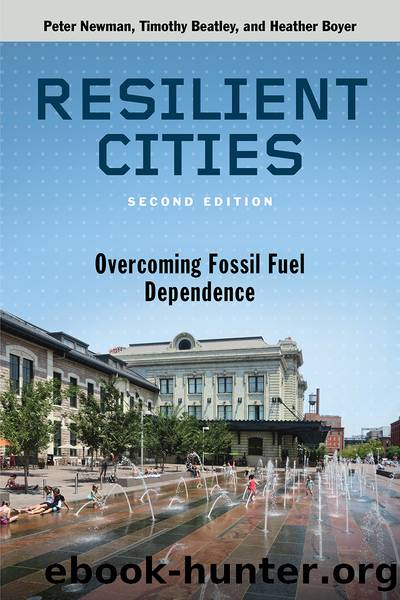Beyond the Knowledge Trap: Developing Asia's Knowledge-Based Economies by Thomas Menkhoff

Author:Thomas Menkhoff [Menkhoff, Thomas]
Language: eng
Format: epub
Tags: Business & Economics, Knowledge Capital, Economic Conditions, Development, Economic Development, computers, Information Technology, Technology & Engineering, General
ISBN: 9789814343688
Google: vEq6CgAAQBAJ
Publisher: World Scientific
Published: 2011-11-15T23:14:12.999953+00:00
Bioregional fabric is essentially rural, but of course it still has small settlements that service the city area and thus should be seen as part of the city. Transport can still become zero carbon but is likely to involve biofuels from locally grown cellulose-based systems. The functions of bioregional areas will include all of those described for peri-urban areas but on a bigger scale.
The key to understanding a biophilic urbanism approach to peri-urban and bioregional areas is to see that the same underlying philosophy applies about human settlements and nature: human beings cannot live properly without a daily dose of living nature. Thus these areas need to build that into all that drives the human activities in the two fabrics. They do provide more easy opportunities to be exposed to nature, but every building and activity can be used to separate human activity from nature or integrate it. The integration process will ensure that the activities are more respectful of the areaâs underlying ecosystems and also enable the removal of fossil fuels from the areaâs structure and activities.
The city uses the peri-urban and bioregional areas for various productive land uses, and these all need to be part of the agenda for phasing out fossil fuels and creating regenerative urbanism, in which the city is in fact restoring and renewing the various productive and ecological functions. These periurban and bioregional parts of the resilient city need to be just as creative and experimental in being inclusive, safe, resilient, and sustainable as the more built-up areas.
The special niche of biophilic urbanism has been its focus on getting greenery into and onto the buildings that make up our cities, predominantly through green roofs and vertical greenery, or green walls. These have changed buildings from being concrete and steel, designed to separate urban life from nature, to having living walls and roofs, now seen as habitat sites with a new kind of design aesthetic. As a result, a wide range of designs and methods for integrating nature into the built environment have emerged and continue to evolve.9 The broad elements of biophilic urbanism that overlap with landscape architecture and environmental planning are covered later in this chapter; first we address the two areas in which most new science and engineering for bringing nature into cities have grown: green roofs and green walls.
Download
This site does not store any files on its server. We only index and link to content provided by other sites. Please contact the content providers to delete copyright contents if any and email us, we'll remove relevant links or contents immediately.
Zero to IPO: Over $1 Trillion of Actionable Advice from the World's Most Successful Entrepreneurs by Frederic Kerrest(4229)
Machine Learning at Scale with H2O by Gregory Keys | David Whiting(4102)
Never by Ken Follett(3760)
Harry Potter and the Goblet Of Fire by J.K. Rowling(3758)
Ogilvy on Advertising by David Ogilvy(3481)
Shadow of Night by Deborah Harkness(3277)
The Man Who Died Twice by Richard Osman(2977)
Book of Life by Deborah Harkness(2851)
0041152001443424520 .pdf by Unknown(2769)
Will by Will Smith(2767)
My Brilliant Friend by Elena Ferrante(2758)
How Proust Can Change Your Life by Alain De Botton(2726)
The Tipping Point by Malcolm Gladwell(2702)
Purple Hibiscus by Chimamanda Ngozi Adichie(2621)
How to Pay Zero Taxes, 2018 by Jeff A. Schnepper(2577)
Hooked: A Dark, Contemporary Romance (Never After Series) by Emily McIntire(2482)
Rationality by Steven Pinker(2271)
Borders by unknow(2213)
Can't Hurt Me: Master Your Mind and Defy the Odds - Clean Edition by David Goggins(2146)
